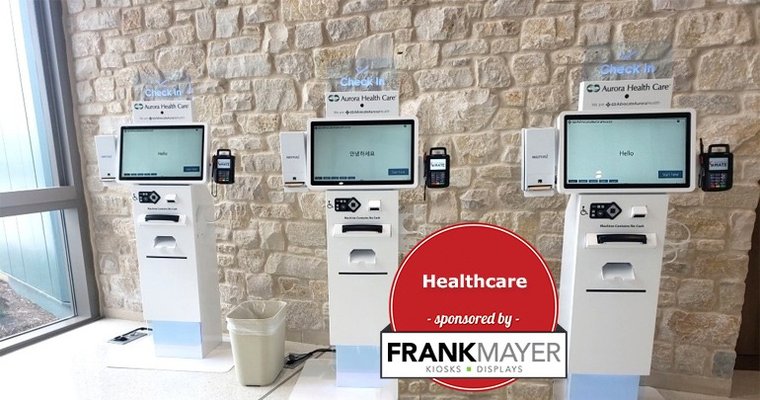Self-check-in kiosks allow greater workflow efficiency for providers and staff, reduce costs and safeguard protected health information.
 Image courtesy of Frank Mayer and Associates Inc.
Image courtesy of Frank Mayer and Associates Inc.
Patient care has long been a key focus of medical technology, encompassing patient sign in, health screening, health alerts, medical record keeping and taking clinical measurements.
For the average consumer, patient self-check-in has become the most visible advancement, as care giver organizations find it improves patient care while boosting staff efficiency and helping address a critical shortage of health care employees.
But technology continues to advance, with new capabilities on the horizon.
«We are continuously learning about and evaluating all technological options that can provide value to a self-service solution,» said Edward Roberto, account executive for kiosk solutions at Frank Mayer and Associates Inc. «There are a lot of different departments affected by the patient intake process from registration, patient care, healthcare information systems, business office and more.
«There are options that are more software-integrated, using wireless connectivity to an individual’s mobile device for navigation,» he said. «There are also hardware integrations using motion sensors and computer vision, and then some very basic PPE solutions using disposable/recyclable PPE product such as FreeStylus.»
Roberto is hardly alone in his enthusiasm for self-check-in solutions for health care facilities.
«Self-check-in kiosks allow greater workflow efficiency for providers and staff, reduce costs and safeguard PHI (protected health information),» agreed Jimmy Juelg, product owner at Healthmark Group, a Dallas based software-driven provider of health information management solutions.
 |
Healthmark Group’s self-check-in kiosk allows greater workflow efficiency. Photo courtesy of Healthmark Group. |
Facilities can measure savings
Juelg noted that health care facilities can already measure the time savings the technology provides by tracking the total number of patient forms completed prior to patient visits, payments collected prior to the visit date and the amount of wait time prior to the visit.
Managers can also glean feedback from patient satisfaction surveys.
Secure, on-demand telehealth
While self-check-in remains the most in-demand function of self-serve telehealth kiosks, another important function is the ability to host secure, on-demand telehealth sessions, said Daniel Boyce, chief product officer at Let’s Talk Interactive Inc., a Charlotte, North Carolina based provider of customizable telehealth solutions including a video conferencing platform, kiosks, medical carts and virtual clinics.
«The ability for a patient to sit down, schedule and then enter an appointment (in a secure location) is so valuable,» Boyce said. «We are seeing this happen across a variety of sectors beyond healthcare. For example, our partner Soldier On is a nonprofit that enables veterans to access mental health support services through self-serve kiosks.»
 |
Let’s Talk Interactive’s tabletop kiosk allows a patient to schedule an appointment in a secure location. Photo courtesy of Let’s Talk Interactive Inc. |
In addition, symptom checkers are essential, Boyce said. Kiosks must enable providers to access patient data including bio-analytics and view various symptoms in real-time.
While mobile devices are helpful in some situations, kiosks offer the benefit of integrating diagnostic sensors capable of measuring blood pressure, heart rate, BMI and glucose levels. The hardware can also be equipped with AI-driven facial-recognition to detect patient emotions.
With connectivity, kiosks also reduce the need for in-patient examinations. Patients can interact with a doctor anywhere in the world, thereby alleviating pressure on available service capacity.
Going forward, healthcare kiosks will be especially important to health care providers as the sector still faces workforce shortages and increased safety measures in the wake of the recent coronavirus pandemic.
This is especially important in light of the fact that trained healthcare professionals are expensive and in short supply.
Trained staff critical
Health care professionals are quick to note that self-service technology does not diminish the importance of trained staff.
Keith Froleiks, chief financial officer at Rockland Eye Physicians & Surgeons, stated that the practice’s goal from the beginning was to improve patient care and staff efficiency, not to reduce labor, in both its West Nyack and Garnerville, New York locations.
In addition to patient check-in, the digital platform integrates with other clinic functions, further improving the organization’s efficiency: patient scheduling, insurance eligibility, patient communications, medical records and practice management, Froleiks said.
Providing up-to-date insurance information has also been a significant benefit to the staff, he said.
Innovation will continue
The impact of digitization on the health kiosk market will remain high, according to a market research report from Transparency Market Research, due primarily to enhanced user experience and increased cost savings.
As solutions continue to evolve, care facilities will invest at a rapid rate. The TMR report pegs the annual growth rate of health care kiosks at 18% through 2027.
«Organizations looking to offer a telehealth kiosk should consider the footprint of the device — look for a lightweight device with a small footprint for most situations,» Boyce of Let’s Talk Interactive said. «Second, ensure the device has the right amount of connectivity including Wi-Fi, hardline, USB ports for medical devices, high-quality camera, speaker and microphone and Bluetooth compatibility. Lastly, look for an aesthetically pleasing model and built-in secure functionality.»

